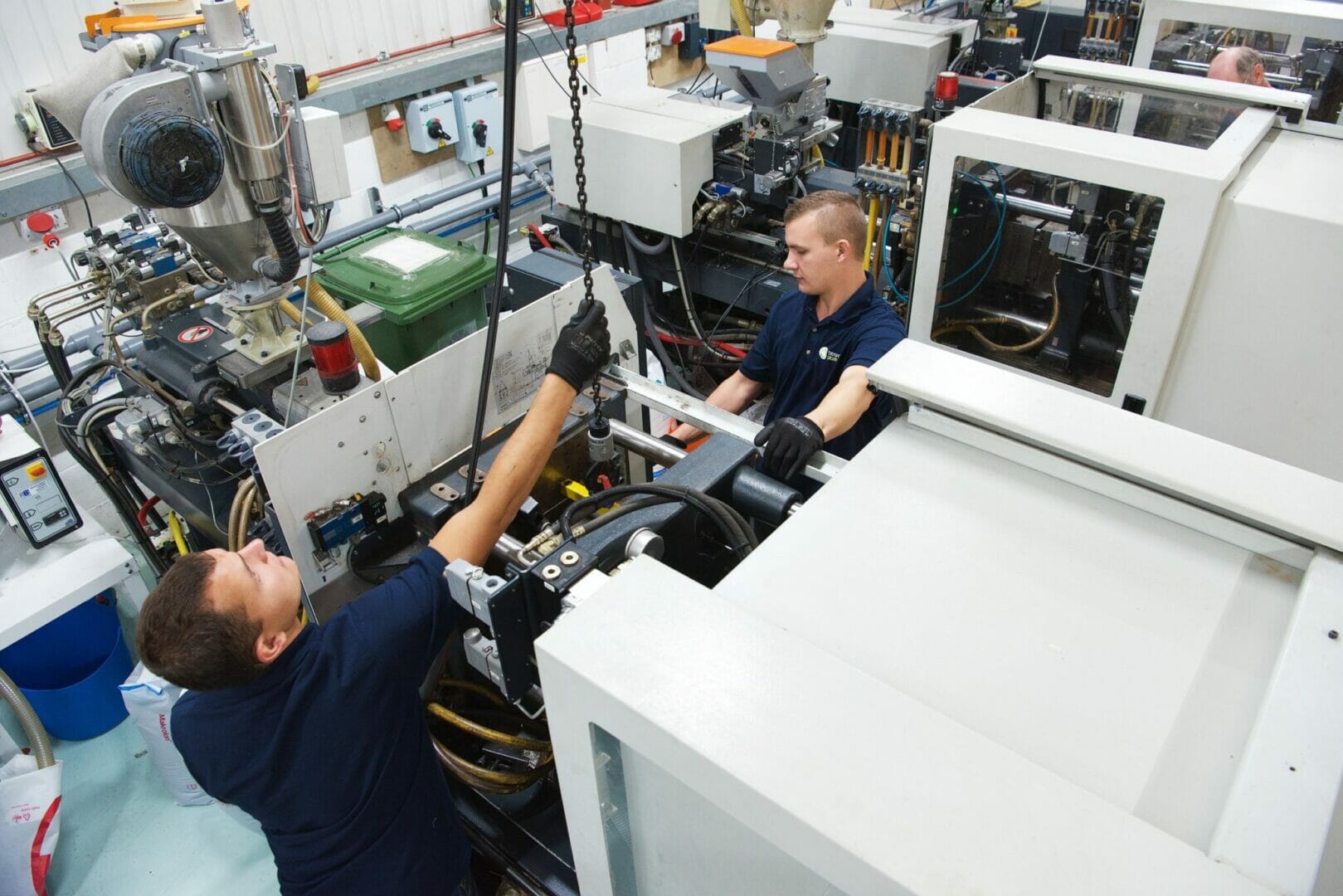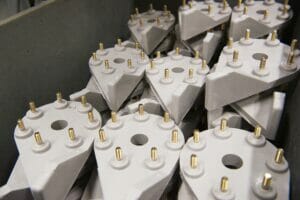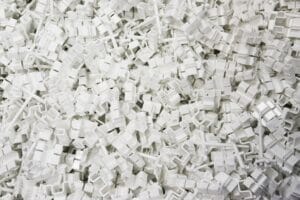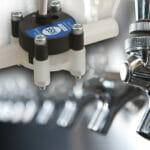Over the past century, the aim to manufacture quality parts using the least amount of time and resources has led to the emergence of two popular techniques: injection moulding and compression moulding. Both come with their own unique set of advantages, but how do you know which process better suits your production? Thomas Catinat, Operations Manager of Broanmain Plastics, explains.
Increasing demand for plastic components has driven the market growth for plastic moulding technology from various industries including packaging, automotive, home appliances, electronics and medical devices. Over the past ten years, the injection moulded plastic parts segment has witnessed a significant surge, reaching US$258.2 billion in 2019 and expecting a CAGR of 4.6% between 2020 and 2027.[1]
Nevertheless, for basic plastic parts made with thermoset materials, compression moulding remains a popular technique, especially for gaskets, seals, and grommets. “Although injection moulding is more widely used, both techniques are needed by specific industries, depending on a number of factors such as volume, material used and functionality,” says Thomas.
Another approach Broanmain offers is direct screw transfer (DST) moulding, where the two technologies essentially meet in the middle by allowing compression materials to be moulded vertically in an injection machine. Thomas adds: “Although DST has been around for decades, the flexibility of this technique is yet to be realised by many UK manufacturers.”
In a nutshell
Injection moulding is a frequently utilised, automated manufacturing process for producing parts by injecting molten material into a mould. It can be performed with a variety of materials, most commonly thermoplastic polymers. Injection moulding machines generally comprise a material hopper, a plunger and a heating barrel.
Once the metal mould for the product part has been designed, it is created to the desired shape either as a single piece or moulded in multiple tool cavities. Plastic granules are fed into the heated barrel, mixed using a helical shaped screw and injected into the mould, where it cools and solidifies to the required shape before being ejected from the machine.
Compression moulding, on the other hand, is a traditional forming method which relies on heat and pressure to mould plastic materials. The first step involves the creation of a strong, precise metal tool designed to the required dimensions and shape.
A compression moulding machine places partially heated material into the open, heated mould cavity. The mould is then closed with a top force or plug member, where pressure and heat is applied to ensure the material reaches all parts of the cavity. The part is then cooled and cured into shape. Finally, the part is removed from the tooling where it is trimmed down. If intricate details are required, these are often created on a CNC mill.
Broanmain offers compression moulding using Bulk Moulding Compound (BMC). Also called Dough Moulding Compound, the composite is a polyester ‘dough’ material that is manually put into the tool in pre-measured amounts. Using pressure, it is then forced into the cavities when the tool is shut. The mould is heated and the heat and pressure is maintained until the material sets.
DST, on the other hand, allows for the processing of thermoset materials such as epoxy, phenolic, DAP, alkyd and DMC in an injection moulding machine. Although more time is needed to change the equipment components and barrel, automation speeds up the overall process.
Size, scale and functionality
Currently, injection moulding is considered the most efficient method to mass-manufacture plastic precision parts in large quantities. Machines are programmable and automated, meaning components can be made quickly and accurately with short cycle times. Computer aided design and computer aided manufacturing allow close tolerances during the making of the moulds.
The key benefit of injection moulding is the versatility when adding details to the finished product. Due to the high pressure delivered by this technique, the plastic is pressed harder against the mould when compared to other processes. This allows for more complex geometrics to be integrated into the design which would have otherwise been too expensive or complicated to manufacture. For high volume production the cost is more viable.
“Thanks to its ability to produce more complex, detailed shapes and plastic components, injection moulding counts for a large amount of plastic products that people use every day,” adds Thomas. “With such flexibility in shape, size and style, the type of products that Broanmain offers varies, ranging from products as small as micro filters, electrics & battery casings, to those as large as scale casing and large floor tiles.”
Because compression moulding machines must bring material up to curing temperatures, the process is slower, particularly for larger parts. Production time is also made longer as the excess flash around the parts must be trimmed after production. It also requires more manual supervision to remove and finish parts. Where the compression method is beneficial is shaping highly durable parts with significant thickness. The compression moulding tool makes even stiff and high durometer plastic materials perfectly vulcanised and dimensionally stable.
This durability makes compression moulding ideal for stable parts such as aerospace and railway components, thermal electrical fittings, switches and valves that resist chemical corrosion, fire- and impact-resistant safety equipment and medical devices. Additionally, the technique is often used by the automotive and transportation sectors for hoods, fenders, spoilers and scoops.
“A majority of the time, compression moulding is used to create legacy components used in trains, planes and electrical parts. Here, production volumes can be as low as 10 per year. In this case, it’s not financially viable to invest in the development, tooling and testing required for injection moulding,” states Thomas.
The benefit of DST is the ability to use durable and low cost materials traditionally compressed horizontally, such as thermoset polymers, switching to a vertical injection moulding technique to achieve a more complex detailed component.
- Inserted compression components like these are designed to be robust and need to be dimensionally stable
- Injection moulding is considered the most efficient method to mass-manufacture plastic precision parts in large quantities
Environmental footprint and production costs
Injection, compression moulding and DST are used by numerous industries to reduce their overall carbon footprint, including the lightweighting of vehicles and aircrafts and building parts for insulation and double glazing windows.
“Studies show that for every 10 per cent reduction in vehicle weight, fuel consumption can be cut by about seven per cent,” notes Thomas. “These benefits were realised by Johnston Sweepers when they chose Broanmain to help them switch from metal fabricated components to plastic injection moulded parts for their municipal and contractor cleansing vehicles.”
With such a focus on sustainability and reducing plastic consumption, customers often ask about the environmental impact of each technique. Not only in the context of social corporate responsibility, but also overhead costs. An advantage of injection moulding is that it ensures the mould is more precisely filled and material essentially drives out any air as the cavity is filled, resulting in less plastic waste. Furthermore, excess thermoplastic polymers can be melted down and reused if required.
Automation saves manufacturing costs and, with the majority of the process performed by machines with only a single operator, the overheads for production are lower. As the parts are finished and ready to go after they are ejected from the machine, very little post-mould work is required.
Manufacturers tend to focus on the waste associated with compression moulding because the cavity has to be overfilled to a certain degree in order to achieve the pressure required to cure the part. As with DST, excess thermoset rubber or plastic generally cannot be melted down or reused so these costs should be accounted for when developing a production plan.
Although compression moulding is more straightforward, it does require more resourcing and the skillset needed to carry out the process is higher, emphasises Thomas: “That’s not to say savings and efficiency requirements aren’t met elsewhere. Features used in other production processes such as gates, sprues or runners are not needed in compression moulding. The opening of compression moulds is larger, meaning material is sent through to the cavity without hindrance and so less material is wasted during the transfer.”
Without a transfer cycle or injection function, there is less groundwork involved. What’s more, compression moulding is able to take place using old or existing tooling. Tools can be made of aluminium or lower cost grades of steel to cut costs further, although it’s important to take into consideration the necessity of using materials capable of withstanding a high pressure environment.
A splash of colour
When comparing the various technologies, certain favourable characteristics are associated with all three. This is certainly the case with adding colour into the mix. Although the surface of plastics can be painted, pad printed or treated post moulding, using colour pigment additives ensures that the decorative features run through the entire product and won’t wear off.
Pigments can also be used to create an opaque or refractive surface. Compression, injection and DST moulding make it possible to create custom coloured material used to manufacture the parts while implementing efficient colour changeovers for less downtime.
Mould costs are also driven down by the widespread use of each method, although this is dependent on the intricacy and size of the plastic part. The same rule is applied to the extent of supply; the higher the number of manufactured parts, the lower the average cost will be. Typically, a mass moulder generating products such as electronic casings estimates an ROI of 10,000 parts. Therefore, for a thermoset component for example if the volume of part required is low it is most cost effective to use compression, if the volume is high then compression moulding or DST is preferred.
Finding the right supplier
One of the key challenges to compression moulding and DST is simply accessibility; it’s not always easy to find suppliers who know how to process quality moulded parts that are built to last using these techniques. Broanmain has over 60 years’ experience processing all types of thermosetting polymers, with the flexibility, tools, production and assembly resources to undertake manufacturing and prototype projects of all shapes and sizes. On site, Broanmain utilises Bipel, Bradley & Turton, Daniels and Sumitomo (SHI) Demag machines ranging from 25 to 150 tons for compression moulding and 110 to 250 tons for DST.
“We’ve witnessed an unprecedented rise in demand for compression moulding in recent years, which we attribute to the reduction in UK moulders offering both injection and compression moulding,” notes Thomas. “Many suppliers are simply not training new staff in this older technology, so there are fewer moulders with the capacity or resources to meet customers’ delivery demands. We are encouraging more customers to consider the benefits of DST moulding, and have increased the capacity of our compression moulding department, and are developing more team members to support this growth.”
The same level of expertise is applied to injection moulding, where Broanmain is experienced in manufacturing injection moulded products for a wide range of industries, from aerospace, electronics, and defence through to the science, automotive and consumer goods sector.
A time and a place
Certainly, there’s a lot to consider when seeking a supplier to manufacture plastic parts, including machinery accessibility, dimensions and durability, production cycle time and overall costs. With so many variables, establishing the processing parameters is where an engineer’s skill is truly tested. Summing up, Thomas emphasises the importance of seeking a moulding partner that can think creatively and use their engineering acumen and scientific knowledge to present the best moulding options.
Discussing the various part production methods on offer, he concludes: “While a majority of our customers request injection moulding, as the tools are easier and the machines are more versatile, for stronger and more wear-resistant parts produced in low volumes, compression moulding and DST are ideal options. All three methods have distinct advantages that are dependent on the circumstances, from the desired lead time to the details and size of the part. With so many factors to consider, it’s important to seek a moulding company with proven expertise to demonstrate each technique and ensure you make the best decision for your needs.”
[1] https://www.grandviewresearch.com/industry-analysis/injection-molded-plastics-market









